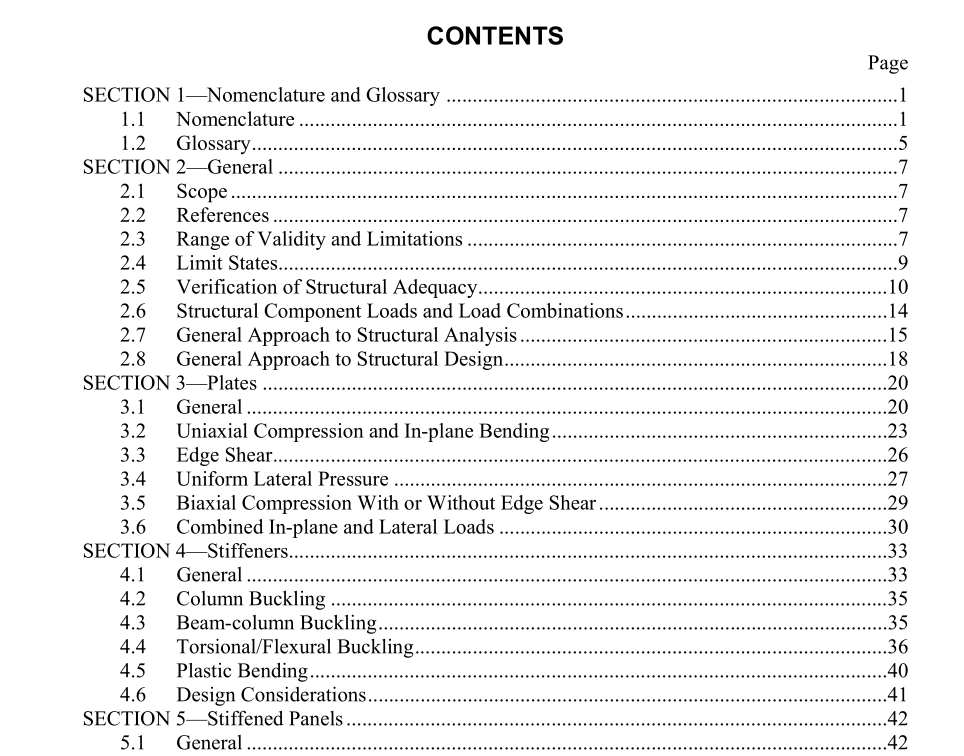API BULL 2V pdf download

API BULL 2V pdf download.Design of Flat Plate Structures
1.2.5 effective flange breadth: The reduced breadth of a plate subjected to bending and/or tensile load, which, with an assumed uniform stress distribution, produces the same effect on the behavior of a structural member as the actual breadth of the plate with its non-uniform stress distribution. While the effective flange width applies to a member under compression, the effective flange breadth applies to a member under bending and/or tensile loading, and is associated with shear lag effects. See 5.6. 1.2.6 effective flange width: The reduced width of a plate subjected to compressive load, which, with an assumed uniform stress distribution produces the same effect on the behavior of a structural member as the actual width of the plate with its non-uniform stress distribution. See 4.1.2. 1.2.7 panel: See stiffened panel. 1.2.8 plate: In Bulletin 2V this term refers to a flat thin rectangular plate, see 3.1.2. 1.2.9 global stresses: Stresses resulting from global deformation of the structure. 1.2.10 proportional limit stress (F p ): Stress above which the stress-strain curve is no longer linear and which represents the onset of plastic behavior. If no specific value for the steel being used is available F p can be taken as 0.60 F y , where F y is the yield stress. 1.2.11 residual stresses: The stresses that remain in an unloaded member after it has been formed and installed in a structure. Some typical causes are forming, welding and corrections for misalignment during installation in the structure. 1.2.12 panel stresses: Stresses on stiffened panels resulting from local applied pressures or transverse loads.1.2.13 serviceability limit state: Function of design variables which defines a condition at which a member no longer satisfies functional requirements, although it is still capable of carrying additional loads before reaching an ultimate limit state. See 2.4.3. 1.2.14 shear lag: Shear effects on beams that cause a non-uniform distribution of longitudinal bending stresses across the flange. 1.2.15 stiffened panel: Structural component comprising one or two sets of equally spaced uniform stiffeners of equal cross section supporting a thin plate. If there is only one set of stiffeners the panel is uniaxially stiffened, and if there are two the panel is orthogonally stiffened. See 5.1.2. 1.2.16 stiffener: Straight and slender thin-walled member of uniform cross which serves as a stiffening element for a flat plate structure. See 4.1.2. 1.2.17 plate stresses: Stresses on a thin rectangular plate resulting from lateral pressure. 1.2.18 tripping: Torsional buckling of stiffener. 1.2.19 ultimate limit state: Function of design variables that defines the resistance of a member to failure (i.e., its maximum load carrying capacity at failure), see 2.4.2. 1.2.20 yield stress: The yield stress of the material determined in accordance with ASTM A307.
2.1 SCOPE
2.1.1 Bulletin 2V provides guidance for the design of steel flat plate structures. These often constitute main components of offshore structures. When applied to Tension Leg Platforms (TLPs) this Bulletin should be viewed as a complement to API RP 2T. The Bulletin combines good practice considerations with specific design guidelines and information on structural behavior. As such it provides a basis for taking a “design by analysis” approach to structural design of offshore structures. 2.1.2 Flat plate structures include thin plates, stiffened panels and deep plate girders, and they can constitute the main component of decks, bulkheads, web frames and flats. The external shell of pontoons or columns can also be made of flat stiffened panels if their cross section is, for example, square or rectangular, rather than circular. 2.1.3 Bulletin 2V is not a comprehensive document, and users have to recognize the need to exercise engineering judgment in actual applications, particularly in the areas that are not specifically covered. 2.1.4 Plates are discussed in Section 3, stiffeners in Section 4, stiffened panels in Section 5, and deep plate girders in Section 6. Limit states are given for each relevant load and load combination, and design requirements are also defined. Figure 2.1-1 summarizes the structural components and the limit states covered in Bulletin 2V. 2.2 REFERENCES Background and references on the contents of Bulletin 2V are included in a Commentary given in the Appendix. Reference is made to API RP 2T, Recommended Practice for Design of Tension Leg Platforms, and API RP 2A, Recommended Practice for Planning, Designing, and Constructing Fixed Offshore Platforms, American Petroleum Institute, and to the American Institute of Steel Construction, Specification for the Design, Fabrication and Erection of Structural Steel for Buildings, latest edition.









